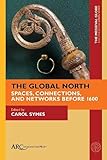The Global North : Spaces, Connections, and Networks before 1600 / ed. by Carol Symes.
Material type: TextSeries: The medieval globePublisher: Leeds : ARC Humanities Press, [2021]Copyright date: ©2021Description: 1 online resource (183 p.)Content type:
TextSeries: The medieval globePublisher: Leeds : ARC Humanities Press, [2021]Copyright date: ©2021Description: 1 online resource (183 p.)Content type: - 9781641894906
- online - DeGruyter
| Item type | Current library | Call number | URL | Status | Notes | Barcode | |
|---|---|---|---|---|---|---|---|
 eBook
eBook
|
Biblioteca "Angelicum" Pont. Univ. S.Tommaso d'Aquino Nuvola online | online - DeGruyter (Browse shelf(Opens below)) | Online access | Not for loan (Accesso limitato) | Accesso per gli utenti autorizzati / Access for authorized users | (dgr)9781641894906 |
Frontmatter -- CONTENTS -- LIST OF ILLUSTRATIONS -- Introduction: Exploring the Global North, from the Iron Age to the Age of Sail -- Contesting Marginality: The Boreal Forest of Middle Scandinavia and the Worlds Outside -- Archaeological Evidence for Staraya Lagoda as an Early Scandinavian Emporium of the Global North -- Gunhild’s Cross and the North Atlantic Trade Sphere -- The Far North in the Eyes of Adam of Bremen and the Anonymous Author of the Historia Norwegie -- The Multi-Layered Spatiality of the Global North: Spatial References and Spatial Constructions in Medieval East Norse Literature -- Military Migration in the Baltic Sea Region, ca. 1400–1620 -- Old and New Land in the North and West: The North Atlantic on the Medieval Globe around 1500 -- INDEX
restricted access online access with authorization star
http://purl.org/coar/access_right/c_16ec
When Janet Abu-Lughod sketched the contours of a medieval “world system” in 1989, she located most communication networks in the southern hemisphere. In recent decades, however, new trends in research and new forms of evidence have complicated, enriched, and expanded this picture, geographically and chronologically. We now know that vast portions of the world were interconnected throughout the Middle Ages and, moreover, that the entire circumpolar North was a contact zone in its own right. In this volume, scholars from a range of disciplines explore the boreal globe from the late Iron Age to the seventeenth century, offering fresh perspectives that cross the frontiers of national historiographies and presenting new research on migration, trade, mapping, cultural exchange, and the interactions of humans with their environment.
Mode of access: Internet via World Wide Web.
In English.
Description based on online resource; title from PDF title page (publisher's Web site, viewed 01. Dez 2022)


